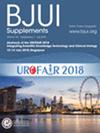Treatment variations in localised prostate cancer in Australia and New Zealand: a registry study
IF 4.4
2区 医学
Q1 UROLOGY & NEPHROLOGY
引用次数: 0
Abstract
ObjectiveTo describe the patterns of care and factors associated with treatment uptake of localised prostate cancer, using the bi‐national Prostate Cancer Outcomes Registry–Australia and New Zealand (PCOR‐ANZ) database.MethodsData for 36 504 patients, diagnosed between 2015 and 2018, from New Zealand and seven Australian jurisdictions were evaluated. Multinomial logistic regression was performed to identify factors associated with the likelihood of receiving no active treatment, radiotherapy (RT), androgen deprivation therapy (ADT) and combined ADT + RT, compared to radical prostatectomy (RP).ResultsThe most common disease risk group and treatment were intermediate‐risk disease (49.2%) and RP (40.3%). Men with low‐risk disease were mostly managed by no active treatment (81.5%). Compared to men treated with RP, the likelihood of receiving other treatments was higher in residents from regional areas, those from lower socio‐economic status (SES) areas and those diagnosed at regional or public hospitals. Being in the lowest SES group was associated with an odds ratio (OR) of 1.84, (95% confidence interval [CI] 1.67–2.02) of having no active treatment, an OR of 1.53 (95% CI 1.32–1.78) for RT, an OR of 2.66 (95% CI 2.10–3.36) for ADT and an OR of 2.56 (95% CI 2.23–2.93) for ADT + RT.ConclusionsFactors related to SES and hospital provider were associated with treatment choices in localised prostate cancer patients, independent of their age or disease risk classification.澳大利亚和新西兰局部前列腺癌的治疗差异:一项登记研究
目的利用两国前列腺癌结局登记-澳大利亚和新西兰(PCOR - ANZ)数据库,描述与局部前列腺癌治疗吸收相关的护理模式和因素。方法对2015年至2018年间确诊的36504例患者的数据进行评估,这些患者来自新西兰和澳大利亚七个司法管辖区。采用多项logistic回归来确定与根治性前列腺切除术(RP)相比,不接受积极治疗、放疗(RT)、雄激素剥夺治疗(ADT)和ADT + RT联合治疗的可能性相关的因素。结果最常见的疾病危险组和治疗是中危病(49.2%)和RP(40.3%)。低危性疾病的男性大多不接受积极治疗(81.5%)。与接受RP治疗的男性相比,来自地区、社会经济地位较低地区以及在地区或公立医院诊断的患者接受其他治疗的可能性更高。最低SES组与一个优势比(或1.84),-2.02(95%可信区间[CI] 1.67)没有积极治疗,OR为1.53 (95% CI 1.32 - -1.78) RT, OR为2.66 (95% CI 2.10 - -3.36) ADT的或为2.56 (95% CI 2.23 - -2.93) ADT + RT.ConclusionsFactors SES和医院提供者与局部前列腺癌患者的治疗选择相关,独立于他们的年龄或疾病风险分类。
本文章由计算机程序翻译,如有差异,请以英文原文为准。
求助全文
约1分钟内获得全文
求助全文
来源期刊

BJU International
医学-泌尿学与肾脏学
CiteScore
9.10
自引率
4.40%
发文量
262
审稿时长
1 months
期刊介绍:
BJUI is one of the most highly respected medical journals in the world, with a truly international range of published papers and appeal. Every issue gives invaluable practical information in the form of original articles, reviews, comments, surgical education articles, and translational science articles in the field of urology. BJUI employs topical sections, and is in full colour, making it easier to browse or search for something specific.
 求助内容:
求助内容: 应助结果提醒方式:
应助结果提醒方式:


